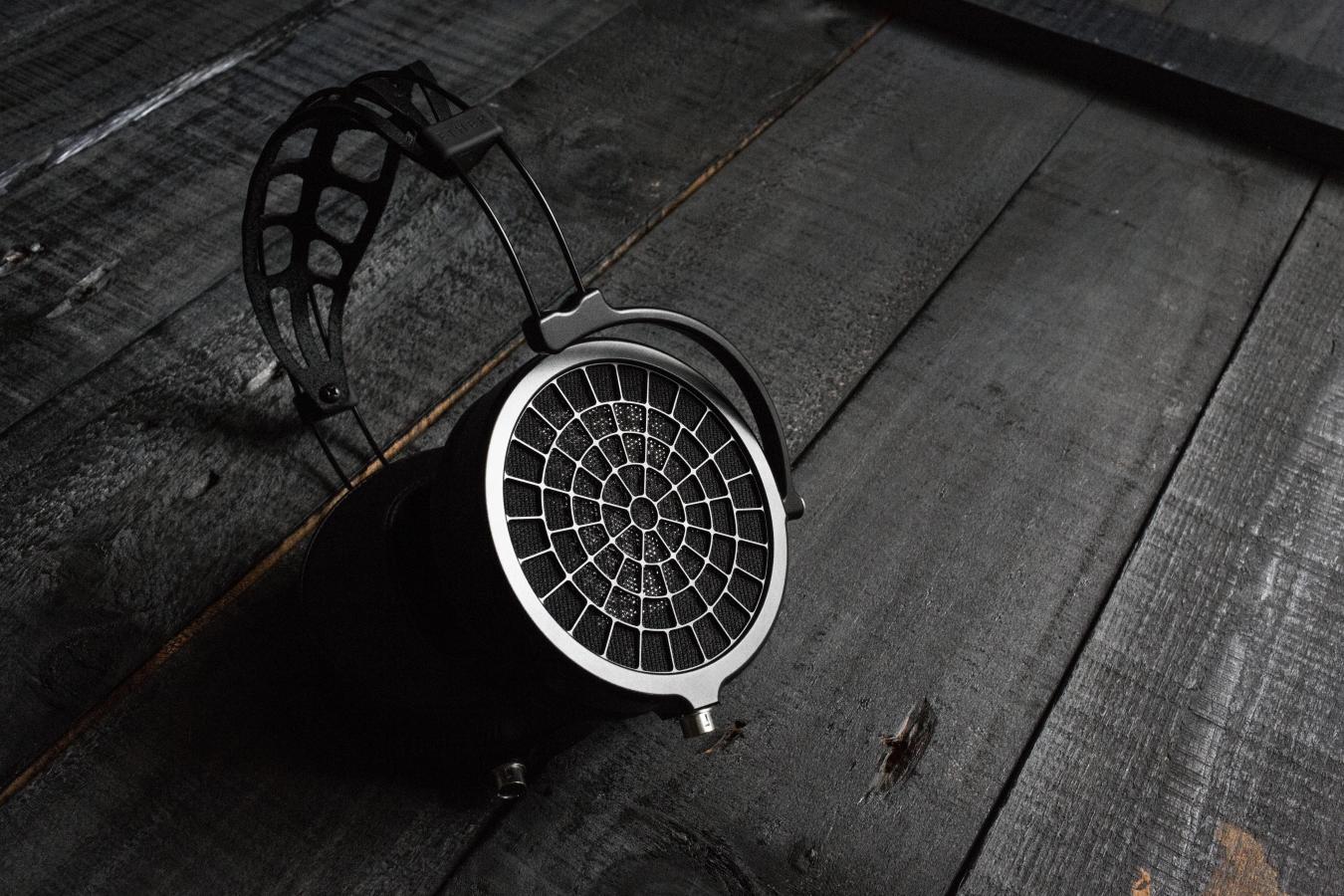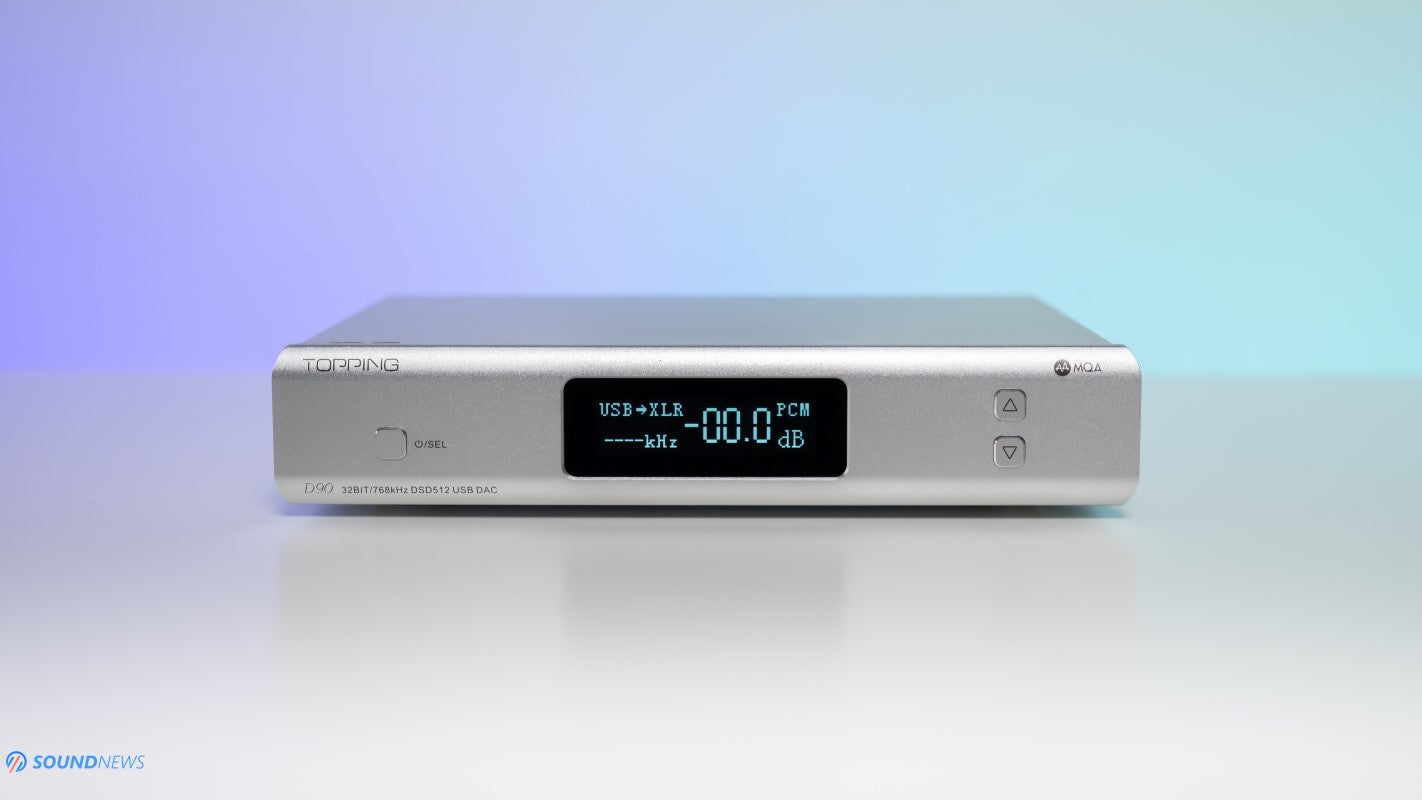
Topping E30 DAC Review – Entry-Level Overachiever
This review is posted here in partnership with Soundnews.net. It was originally written and published by Sandu Vitalie of Soundnews.net on Apr. 14, 2019.
Topping is one of those brands that is just not stopping from releasing new products that cater for the affordable, mid-fi or hi-fi market. The rest of world crumbles in fear, buying toilet paper, canned food or just staying at home quarantined, yet Topping is waving hello with new products every single month. D90 MQA is just around the corner that should be released at the end of this month, much anticipated A90 headphone amp will be here too hopefully just before the summer time and yet they prepared another little surprise that no one knew about, not even us. Topping announced a month ago their newest E series of products from which E30 seems to be the first one: a small, cute and really affordable DAC and preamp combo. With E30 Topping wanted to offer the same legendary sound quality but at the cost of an entry level interconnect cable. They are not joking around as E30 costs just $129.99 in the US and €129 here in Europe, it costs less than any cable at my possession, if it will sound decent enough, I consider that as an added bonus to the small but feature packed device.
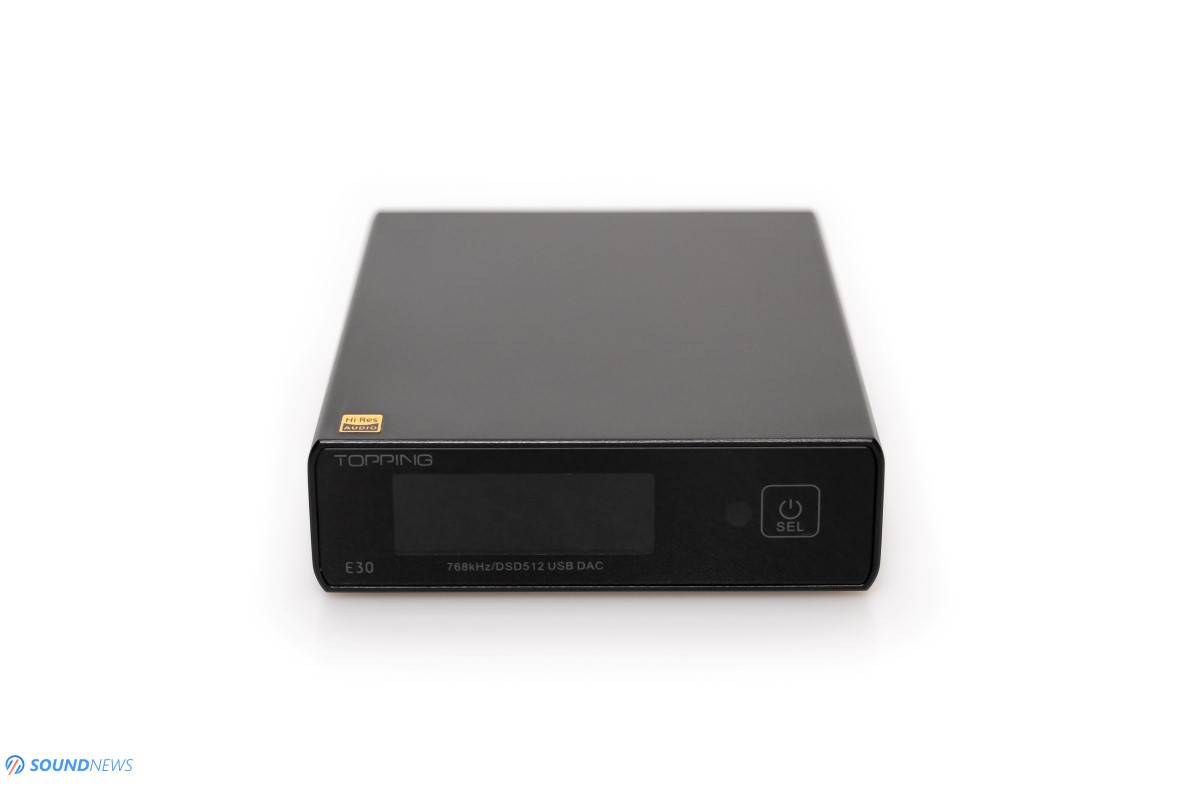
Unboxing & Package Contents
It came in a fairly small box filled with lots of foam, I couldn’t believe at first that a DAC and some accessories could fit inside. Opening it up, I observed that every square inch was used at maximum potential, there is the E30 unit itself, they even put their plastic remote control in the package – the same one is being used with their pricier units. You’ll find a USB type B cable, a USB type A to DC cable for powering the unit and there is some paperwork as a warranty card, an after-sales service card and most importantly the user manual. In super awesome Topping fashion, besides the boring specs, I/O and package contents, you can see in the manual that Topping measured E30 DAC in their labs using an Audio Precision analyzer, they published the RMS level, the exact total harmonic distortion plus noise ratio which sits somewhere between 0.0001 and 0.0002%, pretty amazing right? There is an FFT Spectrum showing the background noise level and also the difference between those 6 digital filters implemented on the hardware level of the DAC chip itself. I said it before that I have a big respect for companies that are publishing real and actual measurements in detriment of some lousy marketing snake oil like Unlimited Jitter Reducer or Dynamic Range Multiplier 9000, who believes that crap anyways? Being honest is the only way to succeed and Topping is part of this group measuring and offering reliable specs to potential customers.
Design & Build Quality
I didn’t test any of the older Topping products, but the ones I tested up to E30 were made from aluminum blocks carved on CNC machines, even the small and cute D50S was entirely carved out of an aluminum block. Obviously, targeting a much lower price point, using CNC machines was out of the question with the small E30. Nonetheless, its body is surrounded by an aluminum case, I have the black version and Topping is also offering a silver version.
I personally find it good looking and due to the fact that it is the size of an external 2.5” HDD drive, it can be easily integrated in any Hi-Fi setup, I even used it with my TV watching some movies on Netflix, it worked great with a gaming console and obviously great in a Hi-Fi setup be it with speakers or headphones.
As with their other units, there isn’t a single visible screw on any side, they moved all those on the back for a much cleaner and minimalist look, I like the way the glass sheet from the front panel is somehow unified with the rest of the case, the LCD screen has 3 brightness positions and the lowest position works great at night and it didn’t even bother the cat eyes of my wife, so the *WAF factor is clearly very high in this one.

Controls & Connectivity
You really can’t have a cleaner look than this without a single button, switch or volume knob on the face plate. Well, almost without a button, since E30 will be powered by touching the right touch panel for a few seconds, an elegant approach for powering the unit. The biggest part of the front panel is occupied by that easy to read LCD screen where by default it will show the selected digital input, the selected volume in dB and the data stream that is playing, in PCM or in DSD.
If you don’t plan on using the E30 as a preamp, I strongly recommend putting the E30 in the DAC mode, just enter standby, press and hold the On/Off button on the touch panel for about 3 seconds until you see “DAC” written on screen, release the button and power it on. In this mode, volume position cannot be changed and instead the sample rate will be shown on the screen.
On the back, you will find the 5V DC input, the USB input, an Optical input, a Coaxial input and the RCA output working in pure DAC mode (fixed volume position at 2V RMS) or working in Pre mode where volume can be controlled in 99 steps.
Menu Options
Topping implemented a much simpler user interface compared to the likes of D50S, DX7 PRO, D90 and the rest of the D and DX line and went with something easier to use and control. Once E30 is powered On, a short press on the On/Off button will toggle between those 3 digital inputs and will show “Err” (Error) message if it can’t establish a connection via the selected input and once you put it in the standby mode you can select the PRE or the DAC mode. If you want to unleash its full potential, the included remote will be needed for that.
Besides switching the digital input and selecting the volume level with the remote, there is also an Auto power On/Off button, a mute button, you can selected the desired digital filter (6 filters in total) with a button and you can change the brightness level, which personally for me worked great in setting it up in the living room.
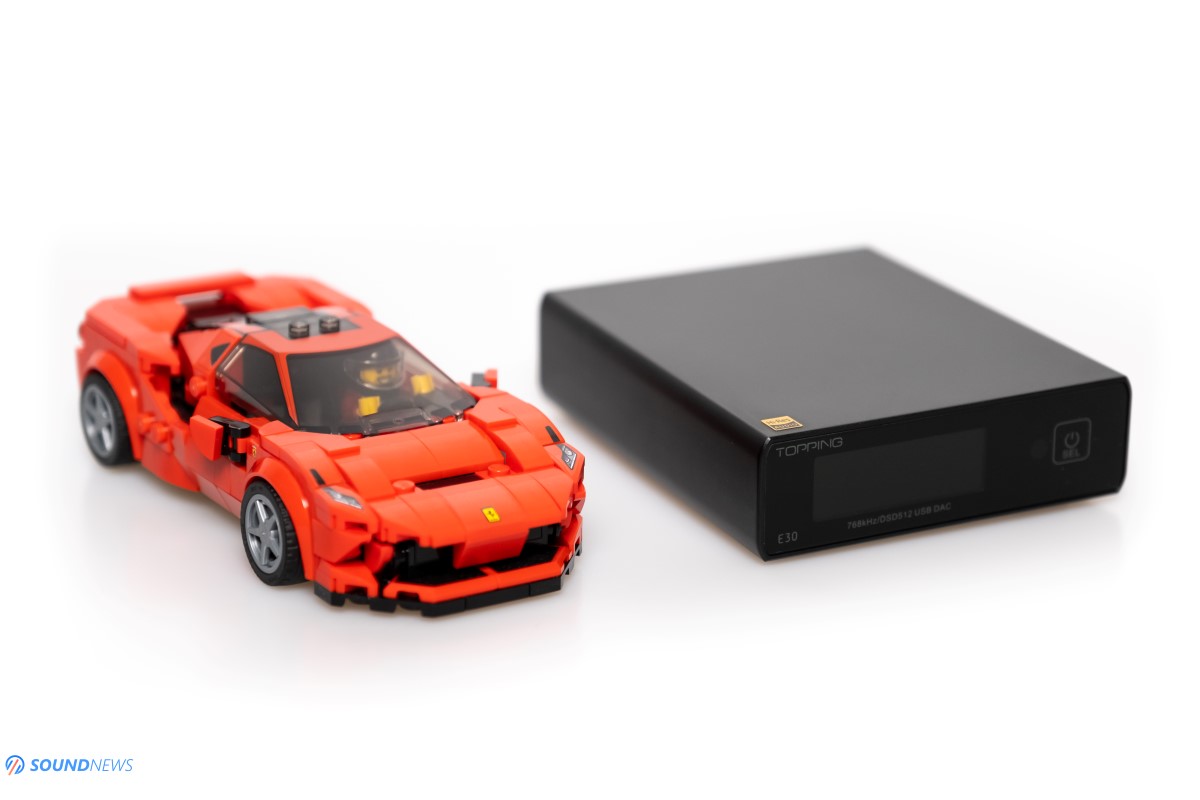
Tech Specs & Detailed Information
Topping went with a single, but fairly new DAC chip of Asahi Kasei, it is the AK4493 that is part of the Premium line of digital to analog converters, carrying that famous Velvet Sound Technology – mimicking a bit the naturalness of the R-2R designs. For the Optical and Coaxial input, an AK4118 receiver chip was used, Topping is using this one in most of their DACs for its low jitter and stability. As for USB, the newest XU208 from XMOS is doing all the hard work. From tens of USB receiver chip, to me XMOS is still the most reliable and most stable chipset I experienced. Thanks to it, E30 is capable of receiving and decoding 32-bit 768 kHz PCM files and DSD512 via USB. If you want a better driver integration, I recommend installing the custom Thesycon drivers from the Topping website.
Tips & Tricks
Since I wanted to squeeze the best out of E30, I used it in a headphone system powering a super linear and really transparent Benchmark HPA4 and then followed by some detailed sounding planar-magnetic headphones. I also used it in a speaker setup as a pure DAC, followed by a Benchmark HPA4 working as a preamp and then by a KECES S125 as the power amp playing tunes on a pair of Buchardt S400 loudspeakers. Having a transparent acoustic chain, detecting issues with E30 is becoming such an easy task.
The biggest issue I had was with its DC input, or more exactly how clean is the power it receives. Since I used it a lot in front of a desktop PC, I first powered it by the frontal USB ports of my PC and there was a big disappointment on my face, as the background from black turned gray and from perfect silence I was hearing a bothersome low intensity pitch. I had almost the same experience with Topping D50S, so I decided moving to the rear USB ports of my PC. Noise lowered significantly, but still I would hear it at louder passages when an absolute silence would appear for a second or two. Moving to an external smartphone charger, things improved considerably and finally it started sounding like a respectable DAC. I still remember what a positive impact had an external power bank on D50S, so I thought: what the hell, let’s try it out. With it, the noise floor dropped to such a point, that I can’t spot it even with my super sensitive FiiO FH7. The lesson is simple, stay away from noisy USB ports, use external power as much as possible, a smartphone charger will work great but a power bank will unleash the full potential of the E30 offering the blackest and the cleanest background. For the biggest fans of the E30 out there, you can easily go overboard with a nice external regulated and linear power supply like the Topping P50 – that one is the best one, I was mighty impressed by it powering a A50 + D50S combo so I am sure it would have the same impact on E30 DAC.
OK fellow music lovers, time to press the play button.
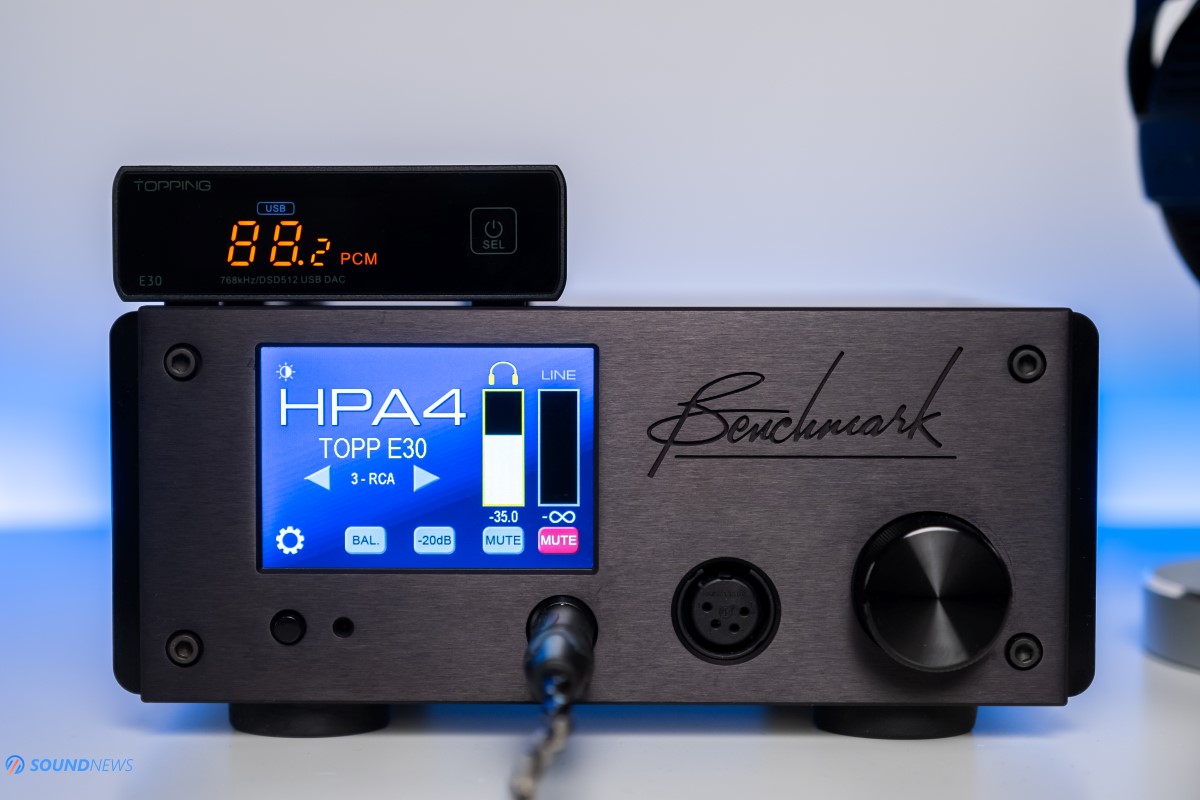
Sound Performance
Maybe Topping cut the costs using a simpler metal case, maybe they used a simpler OSD and menu, they abandoned that Bluetooth input. However, I know where Topping didn’t cut anything and didn’t abandon anyone and that is the sound quality department. I am not saying this because it sounds cool, but because I had a great time with E30, I listened to multiple albums and there were few times when I forgot I’m still on E30 and not on my reference Matrix Element X.
I will start with the most important traits that E30 is having.
I. Sound Signature & TimbreFrom the first seconds, even with my eyes closed I could swear that I am listening to an AKM based DAC. Transparency was great, I could easily look deeper into my tunes, texture was natural and I could feel the body of all acoustic instruments, I could feel the wood of the violins, guitars and I could feel the copper chords vibrating naturally. Soundstage was a bit wider compared to ESS designs and depth was by a smudge going deeper strengthening my findings. There was an apparent smoothness over my tunes, midrange was notably fuller sounding even compared to my reference Element X. I felt the presence of the midrange so much that it even infused a bit of life into the harsher recordings and made older tunes sounding fresher and livelier. Oh, this is definitely an AKM based DAC. The only thing that I could complain about compared to a high-end DAC was the detail retrieval that was not its best trait, I would spot some micro-details but only with my eyes closed. They are still there, but are not screaming for attention and prime time. Treble lovers would be slightly disappointed to know that E30 is playing the safe game, rendering it natural and clear but without the over sharpening some DACs are doing nowadays. It sounds quite life-like, but without that sharp outline you normally attribute to ESS Sabre DACs. So, lets deep dive, step by step.
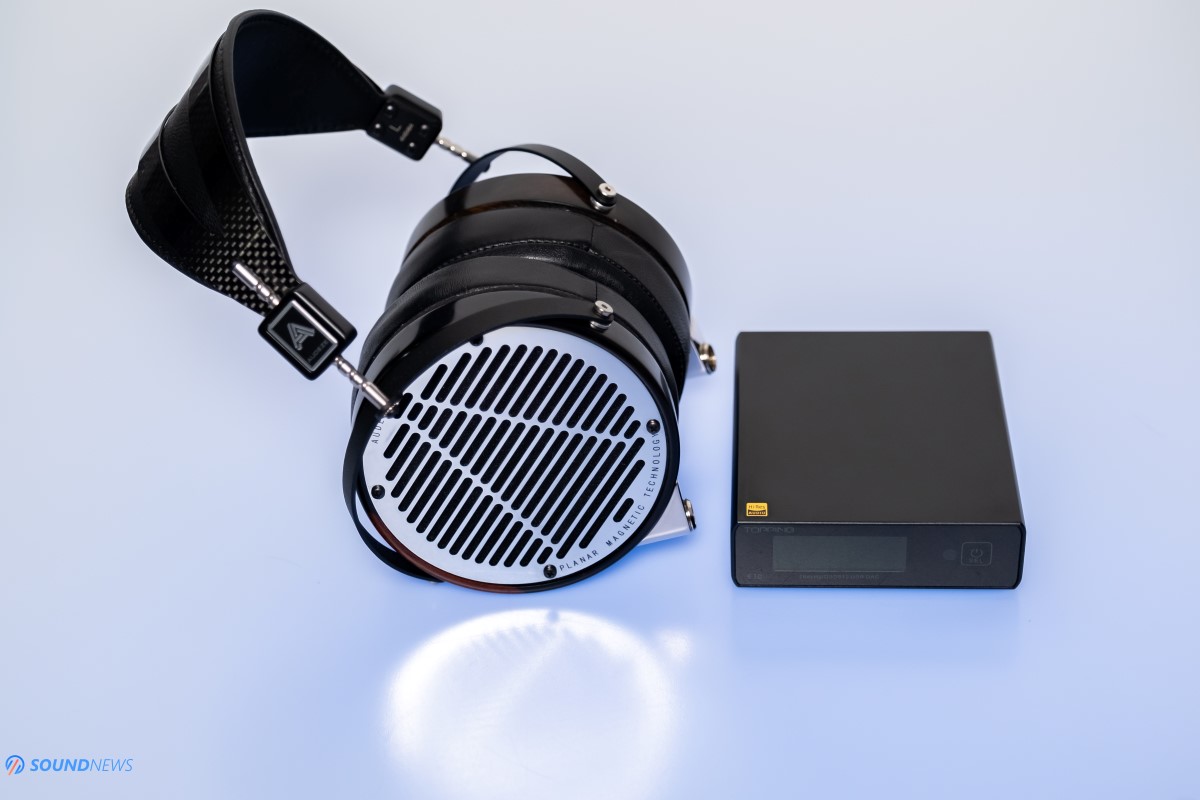
This is where E30 is shining even compared to pricier units. Do note that a very big part of this chapter is directly tied with the background noise. Power it with a dirty USB port, as it was in my case and depth will be polluted, offering a grainy sound with close to zero soundstage. Go with cleaner power and windows will open towards music, grain will disappear and depth information will become noticeable.
Nightwish just released its newest album – HUMAN. :II: NATURE. (2020) and even from the first song called simply Music, I was quite surprised by the play with the left and the right channel, increasing somehow the void space between them. I listened to this album on few digital sources and I can confirm that E30 is having a really good soundstage size, a great pin point imaging and an amazing depth even by listening to crowded music. When the pace intensifies, I observed that E30 didn’t gave up at all and was throwing music in all directions, enveloping the room with decent amounts of air. Even some light gothic metal started sounding like a classical masterpiece. Although the mastering of this album is half decent, E30 is making you forgive all those drawbacks by concentrating your attention of the good parts rather than on the bad parts. Treble for example, from bright on ESS designs sounded a bit calmer and dare I say a bit rolled-off in the upper registers which worked great with this particular album. If you care about soundstage and depth, then I’m pleased to tell that E30 got that pretty good and I really never experienced muddiness, weak airiness or an up-front presentation. E30 is scoring really high in this department and you know what’s cool? E30 outdid even the dual-DAC equipped D50S and sounded about on the same level with DX7 PRO in terms of stage size and depth!

III. Transparency & Detail Retrieval
This pandemic, seems to inspire musicians by releasing new singles and albums. In two weeks, three albums were released from some of my favorite bands. The Strokes released The New Abnormal and the legendary guitarist Joe Satriani – released Shapeshifting, plus that Nightwish album I mentioned before.
The Strokes album sounds so fresh, plays so well with the positioning of all sounds around the listener. I shut down my PC and positioned myself on a cozy sofa engaging the speaker setup. E30 impressed me a lot more with its transparency than with its detail retrieval. Both are interconnected as you can’t have a good detail retrieval without a see-thought transparency – this one is crucial in having an open window to the music. I’m glad The New Abnormal sounded so clean, so alive and so indie, 8 AM in the morning and I am already smiling, that is a very good sign for the small E30. I wasn’t experiencing the last word in terms of ultimate detail, the frequency extremes were just by a hair rolled-off, but everything else sounded oh so engaging, life-like and natural. At $129 I expected much less.
Bad Decisions track played so well with instrument placement around the room, that I needed to relisten to this song on my other sources as well, just to be sure that weird location of a note will sound the same on say Denafrips Venus or Element X. I then moved to listening to all kinds of jazz and E30 was able to show imperfections but to a smaller degree compared to the best sources. I want to point out that E30 is an “optimist” type of DAC, it will highlight the best parts of the FR, will widen and deepen a bit the overall presentation, will show a decent amount of detail but will hide away some of those micro-details and imperfections that could bother in the long run, it will round a bit the treble and will add a bit of color to the music.
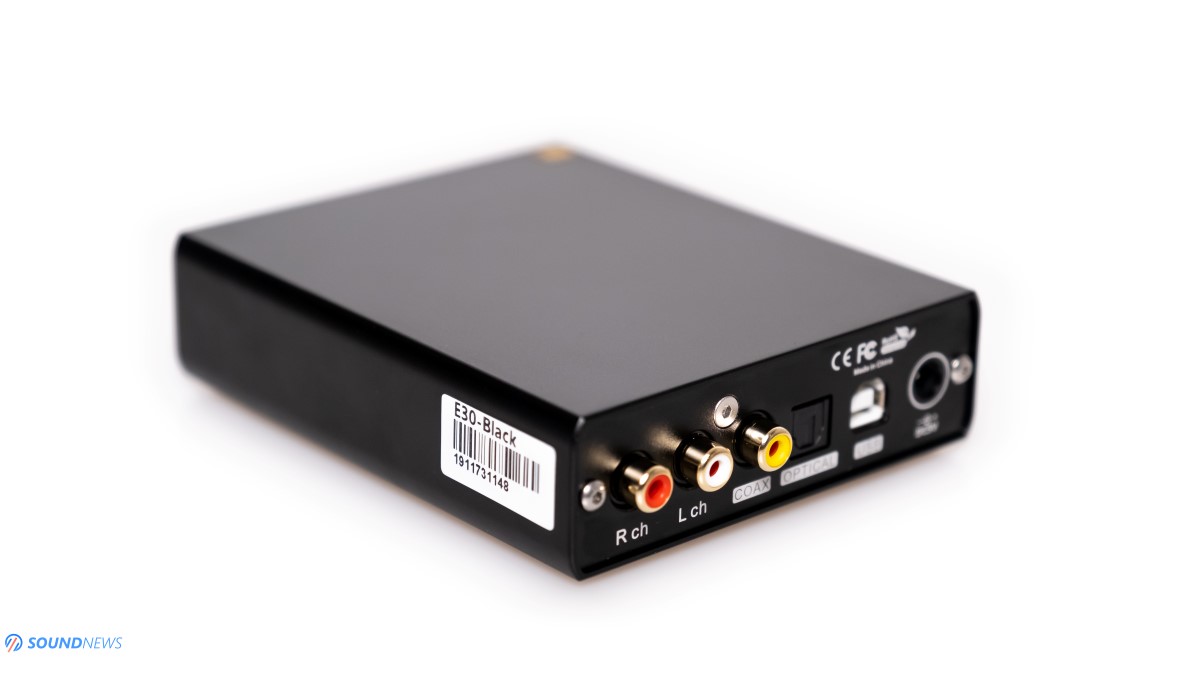
Pair it with a fast sounding amplifier like Benchmark HPA4, Burson Conductor 3 or Flux Lab Acoustics FCN-10 and E30 will start sounding punchy, alive and impactful. I really can’t complaint about its speed and overall enjoyment level. It sounds just by a hair slower than the best ESS Sabre designs, but E30 is not targeted in fighting those devices at all. Even right know I can tell that E30 sounds considerably faster than Loxjie D20 (~$200), about on the same level with Burson Audio Swing ($400). It sounded by a hair slower than Topping D50S ($250) and considerably slower than DX7 PRO ($600). E30 can sound gentle and mellow too with something like an xDuoo TA-30, so it really depends on what follows as the amp stage for the E30.
I personally listen to a lot of punchy and engaging music, I can say it is about 80% of my audiophile diet, so as you might expect transient response is one of the most important aspects for me. Connected to the external power bank, E30 sounded engaging and punchy, without showing signs of being lean or plain boring. I really don’t know how Topping did it, since I know that a good punch can be obtained only with a good power reserve and with a powerful output stage, but looking at its case, I can’t explain how they did it. Secret sauce? Probably.
Moving to Joe Satriani – Shapeshifting which is known for its fast riffs and wild guitar solos is putting some stress on lower quality sources. Yet, from the first solo, E30 kept up with the rise in dynamics and speed, in the end delivering an impactful and speedy presentation so I had no complaints, especially at this price point.

Sub-bass is going deep, hits pretty fast too, carrying a healthy amount of slam and kick into the chest. It is also surprisingly layered, having multiple layers of it on most of my electronic tracks. Even indie rock tracks had quite a special bass guitar that I could focus on pretty easily with the right transducers. Audeze LCD-4 were especially impressive on everything that has a direct connection with bass or midrange. LCD-4 is showing lousy bass notes with weak sources and amplification, again, I don’t really know how Topping did it, but the frequency response is already showing a great potential.
Mid-bass is by a hair more pronounced and makes a splash every time there is some bass in the background. It is indeed pushing greater dynamic swings, but stays clean, undistorted and transparent all the time. It can be considered as a warmer type of bass, there is definitely more tremble down there and a bigger engagement factor to be felt.
Midrange is one of the most beautiful things about E30, it’s always juicy, warm inside, carrying just a bit more naturalness, grabbing my soul every time I hear a voice or some chords vibrating. Midrange has an incredible presence and together with mid-bass, this two ranges are the most impressive in this small unit. E30 slightly elevated the midrange level, making the music sweeter, less digital in a way and more engaging to listen in the long run. I get a healthy dose of dopamine while listening to E30 on some acoustic music, it is always a toe tapping experience and I’m quite a lot into natural and smooth midrange and E30 got that perfectly covered.
Moving to the treble region is done in a smooth way without putting in the shadow some frequency range. Treble has a decent amount of bite and shine, but it is really against any brightness and shrillness. The top octave is present, it’s is a bit harder to spot, but it’s there in decent doses. E30 is only by a hair rolled-off past 15 kHz and that can be felt only by comparing it with higher performing sources. Topping went with a “safe tuning” with this one, wanting to impress a music lover first and an audiophile later on. If would choose between a bright or a warm sounding digital source, I will always go for the warmer variant since it can be paired with a wider variety of amps, speakers and headphones.
I believe the tonal balance is quite impressive on this one, scoring great points in terms of bass and midrange and taming down that upper treble to manageable levels. E30 is quite an overachiever in my opinion as all small portable DAPs at double or triple the price of E30 that can also work as a desktop DAC, can’t hold a candle to its performance as a DAC only device.
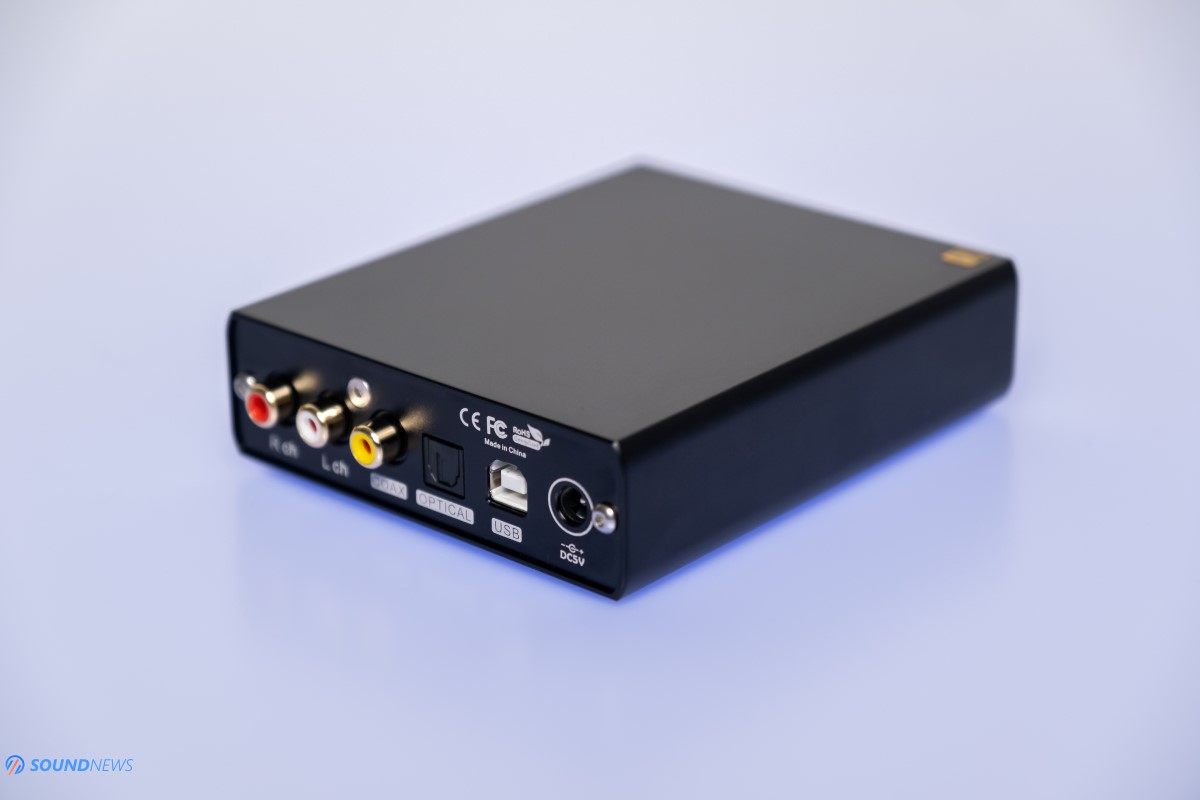
Comparisons
Topping D50S ($250) VS Topping E30 ($129.99)
Both are made by Topping, build quality is really good on both units but D50S wins with its milled case on a CNC machine, it looks like a single aluminum brick, I also like the LCD screen quite a lot more on D50S and its menu and OSD settings are more advanced. In terms of I/O, D50S has a Bluetooth input, otherwise both are identical in terms of inputs and outputs.
D50S uses two pieces of ESS Sabre ES9038Q2M – the mobile variant of the acclaimed ES9038PRO. Both units are outputting maximum of 2V RMS on the RCA out and both can be used as preamps. E30 by comparison is using a single AK4493EQ, part of newest generation of AKM silicon.
Both are powered by a 5V DC input and both are quite susceptible to noise that is powering them, the cleaner in power - the cleaner the sound will be, so I decided using both with external power banks as I have quite a lot of them.
D50S sounds slightly more detailed, it will extract more information out of your tunes and will show almost all imperfections in a track. D50S chooses a very linear frequency response, so much that sometimes it could sound a bit lean or even dry and bright with some particular speakers or headphones. D50S is maybe too linear, especially the midrange area feels a bit dry and not that involving and the treble is extra crispy even past the top octave. D50S can feel brighter with some music, on the plus side some people are associating that increase as a cleaner sounding source. D50S is also by a hair a faster sounding DAC, the decay is also faster, the outline is sharper with D50S and sometimes music is felt like listening through an over-sharpening filter.
E30 is quite a different sounding unit, especially the frequency response feels very different. I consider both having the same agile and deep bass, going really low even touching sub-bass notes. Mid-bass and midrange are definitely fuller sounding on E30, there is more warmth, there is more soul in the midrange, voices are going deeper, strings will vibrate a microsecond longer. You can call E30 as a musical sounding DAC and D50S as a linear sounding DAC. As for treble, E30 is rolling-off a bit some of the top octave, sharpness is exchanged with a natural texture and extreme detail with a bit of smoothness.
E30 is by a hair wider sounding and will throw a bigger picture in front of the listener, depth is better too, but the pin point location of every note around is better on D50S. As much as I have tried to find a winner and a loser, there isn’t such a thing with these two. E30 is all about relaxation, open wide soundstage, warmth and naturalness and D50S is all about detail, linearity and extended frequency response. Different strokes for different folks, really.

Conclusion,
Topping E30 is such an overachiever in every possible way that I can’t tell you enough how awesome it is at such an attractive price point. Putting my objective opinions behind, I can tell you that I liked it more than some pricier digital sources (DACs and DAPs) from the land of the red dragon. E30 is small, cute and really cheap but once you connect it to a serious system, it starts blooming and showing all its awesome skills. I consider it having a great tonal balance, being slightly on the warmer side, infusing just a bit more joy to the listener and increasing the void space between all musical notes. Connect it to a fast sounding solid-state amplifier and all the tiny cons of E30 could be easily counterbalanced.
E30 is an amazing achievement for Topping and if you really don’t need a Bluetooth input, a headphone output or some balanced outputs, E30 could be the perfect unit for a secondary acoustic chain or for anyone that just started this wonderful hobby.
At $129.99, Topping E30 is an amazing value and the one I would recommend from now on at less than $200.
PROS:
- Cute, small, sleek looking device, good build quality
- Easy integration into tiny spaces, very high *WAF
- That LCD screen and the remote control are a godsent for the living room
- Excellent tonal balance, being tilted towards warmth and naturalness
- Transparency is at a very high level and detail retrieval is above decent
- Pretty good pin-point imaging
- Open and wide soundstage, amazing depth too
- Very good speed and control, followed by a nice punch in the chest
- Amazing mid-bass and midrange level – slightly elevated too
- The King in terms of value
CONS:
- Rolled-off a bit in the treble
- It’s sensitive about the power it receives, the cleaner – the better
ASSOCIATED EQUIPMENT:
- Sources: Xiaomi Mi 9T Pro, Corsair One i160
- DACs: Topping E30, D50S, Flux Lab Acoustics FCN-10, Denafrips Venus, Matrix Audio Element X, Burson Conductor 3 Reference, KECES S3
- Headphone Amps: SparkoS Labs Aries, Benchmark HPA4, Flux Lab Acoustics FCN-10, xDuoo TA-30, Burson Conductor 3 Reference
- Integrated Amps: Hegel H190, KECES E40
- Power Amp: KECES S125
- IEMs: FiiO FH7 & some lower tiered ones
- Portable headphones: Sennheiser Momentum 2, Meze 99 Classics
- Full-sized headphones: Audeze LCD-4, Erzetich Phobos, Hifiman Arya, Quad ERA-1
- Loudspeakers: Buchardt S400, KEF LS50W
- Interconnects: QED Reference (x2), Aune AL3
- Speaker cables: Kimber PR8, Audioquest Type4
- Power Cables: Isotek EVO3 Premier (x2)
- Balanced Isolation Power Conditioners: PLiXiR Elite BAC400, KECES BP-600
*WAF = Wife Acceptance Factor


